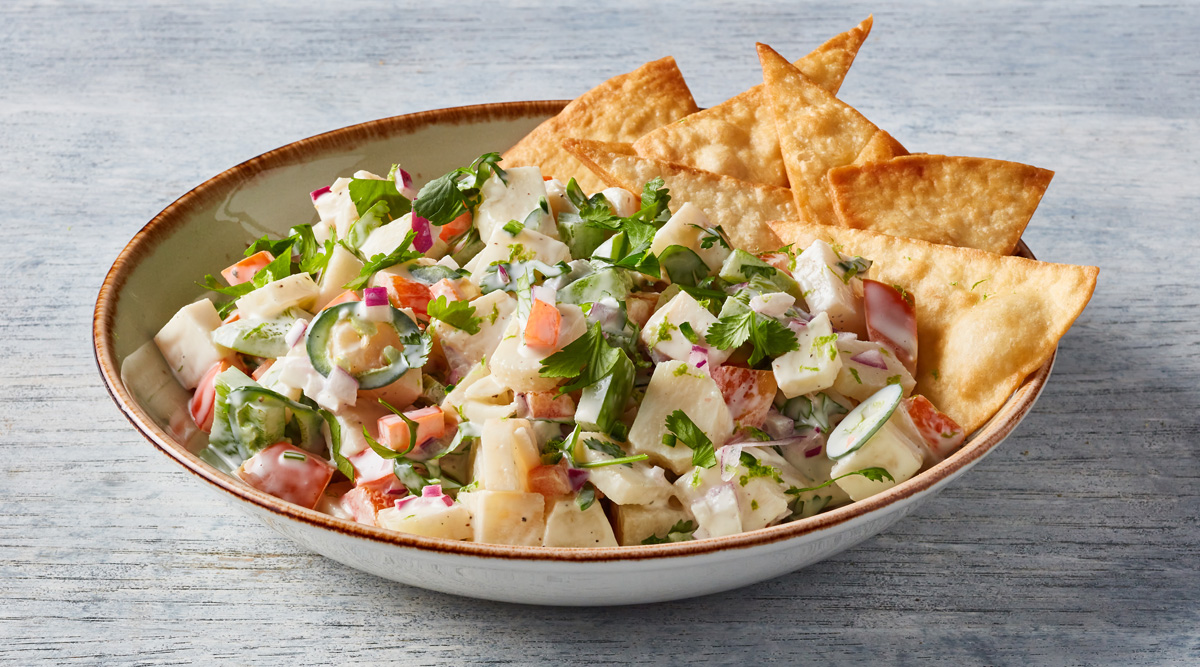2023 Foodservice: Food & Flavor Trends
Foodservice innovation drivers in 2023 include health and wellness, nostalgia, sustainability, and a desire for adventure.

May 2023
Volume 77, No. 4
Trends that were driving innovation before the COVID-19 pandemic may have stalled for the past couple of years, but many now appear to be making a comeback. In fact, according to Datassential, more than three-quarters (76%) of consumers say they are excited for 2023 food and beverage trends.
“Consumers spent years cooped up at home during the pandemic, limited to what they could produce in their own kitchen or get for delivery, so they are ready for the types of foods and options you can only get from foodservice,” says Mike Kostyo, trendologist and an associate director for Datassential. Several trends rose to the top in conversations with experts.
• Health & Wellness Evolution. The pandemic put health front and center for consumers. The latest spins on health and wellness are highly focused on immunity, as well as “feel good” flavor profiles that speak to health but also taste great. Sweet and sugary profiles are moving toward bitter profiles, according to Dillon Friday, senior director of savory at Symrise. The rise of low- to no-alcohol beverages is one example of a growing flavor-first health trend.
• A Taste of Adventure. “Gen Z has a nearly endless thirst for new and novel foods,” says Kostyo. Gen Z is the only generation to say they would choose both Latin and Asian cuisines over Italian, according to Datassential. More than ever, people are interested in underrepresented cuisines, as well. There’s a story to every dish. We now rely so much on social media’s impact, says Joe Choi, a culinologist with CuliNEX.
• Nostalgia & Sharing. Familiar comfort foods, which peaked with the high stress of the pandemic, are shifting toward nostalgia, says Maeve Webster of Menu Matters. She describes food influenced by nostalgia as more playful than comfort food, and notes that it can skew either authentic to the time/place or incorporate modern sensibilities.
“It is not only about the food, but about who is at the table with you,” says Brandon Collins, corporate executive chef of Unilever Food Solutions. He sees sharing as a central food trend that’s all about bonding—from enjoying each other’s company at a big game with a simple sandwich to sharing a reimagined dish from your youth with others. “We are hungry for a new connection now more than ever, and nothing brings people together more than food,” he says.
• Advances in Sustainability. Foodservice is lagging CPG in sustainability trends, but that’s turning around on a variety of fronts. Partnerships that showcase companies doing more to communicate the benefits of their products or companies, like Burger King’s methane-free burger, are growing, says Chef Allison Rittman of Culinary Culture. Likewise, ingredients can be more than what we’ve traditionally used them for, says Collins, who has called out “low waste” as a top trend at Unilever, both for operators and manufacturers who need to try out—and better market—the concept.
Digital Exclusives

FIRST Fireside Chat Presentations
Fireside Chats bring the future into focus and discuss current trends and opportunities.

Business FIRST Presentations at IFT FIRST
The Business FIRST Stage tackles global issues and showcase trends in food, food tech, and the science of food. Business FIRST is presented by IFT's flagship magazine, Food Technology.

10 Food Trend Predictions for 2022
The editors at Food Technology magazine, published by the Institute of Food Technologists (IFT), have announced their predictions for the hottest food trends for 2022.
Food Technology Articles

How to Formulate for Food Intolerances
In this column, the author describes the global prevalence of food intolerances and provides insight into state-of-science ingredient replacement and removal methods when formulating gluten-free and lactose-free foods.

Vickie Kloeris Shares NASA Experiences in New Book, Consumers Are Confused About Processed Foods’ Definition
Innovations, research, and insights in food science, product development, and consumer trends.

Top 10 Functional Food Trends: Reinventing Wellness
Consumer health challenges, mounting interest in food as medicine, and the blurring line between foods and supplements will spawn functional food and beverage opportunities.

Whipping Up a Bright New Idea
A profile of whipped cream category innovator Whipnotic.

Better-for-you products on display at Natural Products Expo West
A photo overview of products shared at the 2024 Natural Products Expo West in Anaheim, Calif.
Recent Brain Food

A New Day at the FDA
IFT weighs in on the agency’s future in the wake of the Reagan-Udall Report and FDA Commissioner Califf’s response.
Members Say IFT Offers Everything You Need to Prepare for an Uncertain Future
Learn how IFT boosts connections, efficiencies, and inspiration for its members.

More on the FDA's Food Traceability Final Rule
In a new white paper, our experts examine the FDA’s Food Traceability Final Rule implications—and its novel concepts first proposed by IFT.
Job Satisfaction in the Science of Food is High but Hindered by Pain Points
IFT’s 2022 Compensation and Career Path Report breaks it down.


